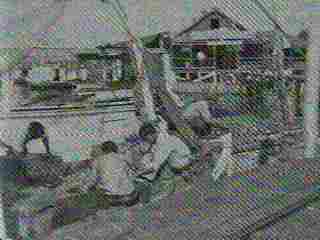
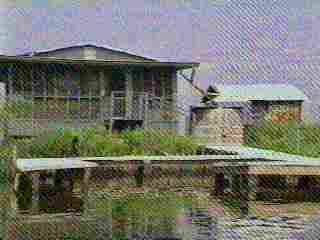
Loading Houses on the Gulf Coast
Manila Village in New Orleans
1895-1965Sorry,
you need a Java capable browser to see this.


Loading
Houses on the Gulf Coast
Just
before the turn of the century, in 1895, a group of Filipinos mostly from
the Southern Philippines settled in a little community near New Orleans.
Rich with the tradition of the Philippines, they started a small Filipino
fishing village. They found the bayous of Louisiana similar to those in
their original island homes. Using their fishing knowledge from the Philippines,
they created what eventually became one of the largest, oldest, and most
popular shrimping villages in Barataria Bay, Manila Village, named after
the capital of the Philippines. The community that supported Manila Village
was home to many Filipino seamen and fisherman, called Manilamen.
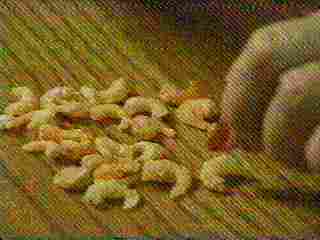

Dried Shrimp
Manila Village Sketch
Dried
shrimp was the most important resource and main product of Manila Village.
Through the hardwork of only a few immigrated Filipinos, Manila Village
became ranked as one of the top producers of dried shrimp. Although a small
presence in a big state, the people of Manila Village made outstanding
contributions to the history and economy of Louisiana. The founders of
Manila Village couldn't have picked a better location to use their fishing
experience. Southern Louisiana had a tropical climate, with a fertile sea
fed by the Mississippi and a warm Gulf Stream. The state's waters yielded
half of the shrimp consumed in the entire United States. The Filipinos
picked Barataria Bay to harvest their shrimp, just south of New Orleans.
Manila Village was located just a few miles southeast of Lafette, fifteen
miles north of Grande Isle, and fifteen miles south of Myrtle Grove.
Although Manila Village was where they spent many hours shrimp processing,
the Filipinos made their home across the small bay to the southwest, on
Cabinash Island. It could have been considered the suburb of Manila Village.
Manila Village, however, wasn't completely exclusive. There were also Chinese
and Europeans from the fishing villages of the Mediterranean who were hired.
The
structure of Manila Village resembled the fishing bays back in the Philippine
Islands. Barely above sea level, Manila Village was built on hand-driven
pilings spread over fifty acres of marshland. These "stilts" held up a
dozen or so red-roofed, green painted buildings
along
the edge of the bayou. Manila Village's foundation came to be known as
"the platforms" and they stretched across the bay. They were made up of
a series of slopes with valleys in between. It's structure was designed
to drain excess water. In addition to platforms that could cover the size
of two football fields, Manila Village had warehouses, a fuel dock, shelters
for late night workers, and a post office, affectionately called
"cabinash."
The
shrimping season normally started in May. For children of the
Village's workers, this meant getting pulled out of school a few weeks
early every year. The village utilized all its help in timely processing
of its famous dried shrimp. The actual catch of shrimp was
obtained by trawlers. They were "lugger"-type boats that dragged a net,
or trawl, along the sea or gulf bottom. "Trawler" is also the name of the
fisherman who uses these
boats.
They always had to have and display their yearly licenses for fishing and
shrimping. Trawlers would contribute their daily catch to the platforms
of Manila village for "washing," or boiling. After the catch, everything
except the shrimp was returned to the sea.


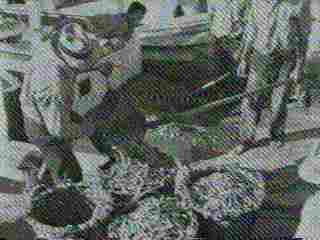
The
drying of the shrimp was a large undertaking every year. For the residents
around Manila Village, the chief occupation was to participate in this
process. The method of sun-drying the shrimp was originally developed in
the Philippines. Thus, along with their
culture
and their community, Manila Village residents brought with them specific
and useful work ideas. The first stage of sun-drying shrimp was to boil
them for about twenty minutes in copper cauldrons of course-salt and water.
Next, the shrimps were spread out in a single layer covering the huge platforms.
The shrimp were then trampled on to remove their heads and hull in a process
named "dancing the shrimp." To insure uniform
drying,
the shrimp were stirred regularly with long wooden rakes.
At
night and during rainy weather, the shrimp were raked to the top of
the slopes and covered with tarpaulin. The entire process of sun-drying
shrimp took three to four days in the summer and five to ten days in the
winter. After the shrimp were satisfactorily dry, they were sent to New
Orleans for export to Asia, Canada, and South and Central America.
On
September 9th of 1965, the entire bustling business of these Filipino immigrants
came to an end. On this day, the very unwelcome Hurricane Betsy disrupted
Manila Village. Betsy's 18-foot swells took with them most of the platforms
and the small buildings, whose
structures
was no match for the winds. Although the entire United States was
able to move on without having to put Hurricane Betsy in its history books,
Betsy definitively made her mark in Filipino-American history. After the
hurricane, only the pilings that held up the platforms and one camp was
left of the entire Manila Village. The Filipinos of Manila Village
had
to turn to deep-sea shrimping, freezing shrimp, and other occupations,
forever diffusing the tight community that the Manila Village once was.
The area that contained Manila Village still produces and supplies
the best shrimp catch in the United States. Drying shrimp, however, has
become a commercial endeavor, against which a small community business
cannot compete.
There
are only a few Filipinos left that can remember the days of Manila
Village. Much of the information mentioned here was taken from Isabel
"Reggie" Welch, who spent her younger days in Manila Village. Her
family history embraces some of the true experiences of the Filipinos at
that time in the Village.
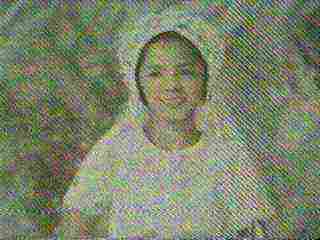


Isabel
Family
Mom
Her
father came to the US around the beginning of the century. He first
worked on California farms and in the salmon industry in Alaska before
joining the US Army during World War I. After the war, he moved to New
Orleans and met and married Reggie's mother. Her mother, a second Generation
Filipino-American, had been living in New Orleans for a while. She
grew up with the early generation of Fil-Am, the Martinez and
Burtanog,
the first documented Fil-Am Family in the United States.
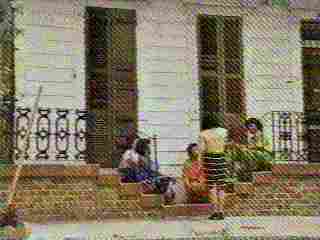
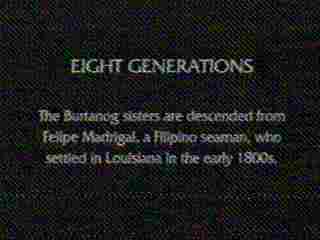
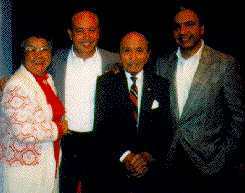
Her
mother's family owned a boarding house in which many people like her father
would stay when they first arrived there. Reggie can remember the early
summers of her life spent on Cabinash Island, and especially on the platforms.
She, like the other children of Manila Village, were consistently pulled
out of school early to work on the harvesting. She remembers the differing
opinions of the children about working in the village, especially the contrast
between her and her sister. Whereas Reggie loved working in the village,
her sister Cecilia hated it. She did not have immidiate male relative.
She grew up like a tomboy. She spent many days with her father; sharing
paddle a piroque, row a skiff, knit a travel, steer the boat, fishing and
digging oysters aroung the Manila Village. Her sister was diffirent who
like staying with their grandmother. Everything changed when whe
was sent to school. Her father reminded her that she was a girl and had
to learn to do the female things. She was very proud. In the tradition
of patriotism started by her father, Reggie later helped the American cause
during World War II. She worked at Higgins Air Craft in New Orleans. It
was here that she earned the nickname Reggie the Riveter, for how hard
she worked. The war ended and, using the scholarship she earned during
the war effort she became a schoolteacher. In 1976 she earned the
title Teacher of the Year in Lousiana.
Her sister, coincidentally, eventually became a school principal. For most of the first generation Filipino-Americans, their parents planned marriages for them within the Filipino culture. For example, the Burtanog sisters of the 18th century were expected to marry other eligible male Filipino bachelors within the small groups they were in. It was common that, even though still in school, young girls were paired with someone. This was the time when the number of Filipino men against women were much higher. The man would often be as old as their father. These girls were born in New Orleans, involved with the American culture, and knew the language as any other American. Remarkably, they played with many schoolchildren newly immigrated from Europe who were only still learning to speak English. The war period later liberated women, as they were allowed more freedom. Thus, Reggie was different, and instead married an Anglo-American. You would never find another woman prouder of her heritage.
Isabel's father never returned to the Philippines. She recalls her father's saying that there would be a ship to take them to the Philippines for a family visit someday as the end of his life was nearing. Her mother was also a strong woman, very fitting for that era.
Although Reggie did not see the aftermath of hurricane Betsy, her father and her sister did, and reported that only the pilings and some riff rafts left over.
The demise of the village accelerated the social assimilation of the Fil-Am community into the New Orleans lifestyle. Originally the place for the amphiantic seafarer to build more Filipino families, the destroyed Manila Village forced them to bind outside the boundaries of their living. Joining the New Orleans community, many children became just a part of main stream Lousiasians all season. It was the end of a cultural existense and unique labor organization. The New Orleans creole community has been more tolerant to diversity than most regions in the South.
Today
as you drive alone US10 along the gulf coast, shrimp, the bounty of the
sea, are now caught and processed farther out, done by larger boats and
onboard self-contained processors. Farther out also are the offshore
oil drilling rigs. The names St Malo and Manila Village are not longer
used. Constantly broken by the fury of hurricanes and meandering Missisipi
River drainage system, the islands have been partially reclaimed by the
sea. Names of powerful Hurricanes like Betsy and Camile are retired
and will never be used again as a timeline in history.
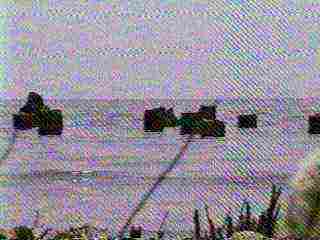
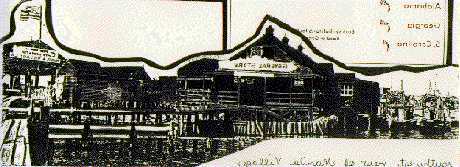
Only the Platform Pilings left
Nestor Palugod Enriquez